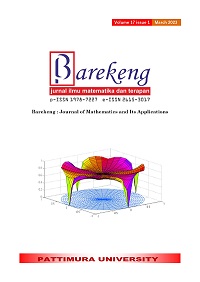EVALUATION OF THE QUEUE SYSTEM OF A DRIVING LICENSE APPLICATION AT KEPOLISIAN SUMBAWA BESAR
Abstract
A driving License (SIM) is a card that a motorized vehicle driver must own to prove the eligibility to drive a motorized vehicle. There are still many drivers who do not have a SIM. One of the reasons drivers don't apply for a driving license is because they object to follow every procedure in making a driver's license, which takes a long time and causes long queues every day. The application for a driver's license in a city or district is only in one place, namely at the City Police. As a result, many applicants apply for a driver's license in the queue system. This problem also occurs in the SIM-making service system at the Sumbawa Police Station. Therefore, this study aims to evaluate the queuing system for SIM-making services at the Sumbawa Besar Resort Police using the queuing theory method. There are two types of submissions in applying for a SIM, namely a new application and an application for an extension of a SIM, and the queuing system model used is Single Channel-Multi Phase. There are three phases in applying for a new SIM: the registration phase, photo phase, and test phase. Meanwhile, the application for a SIM extension has two steps: registration and photos. Based on the results of the analysis, the use of one service in each phase has not been optimal in overcoming the number of queues in the new SIM application process because there is still a steady-state (ρ) greater than one and the number of applicants is still queuing in the system, namely on Monday (phase test), Wednesday (test phase) and Friday (photo phase and test phase). Therefore, it is proposed to add one more service on that day and phase so that the stadium condition (ρ) is less than one and there is only one applicant in the queue (Lq).
Downloads
References
K. Siregar, A. Ishak, and Fernando, “Determining the Number of Optimum Servers in The XYZ Restaurant Queue System with Queuing Theory Determining the Number of Optimum Servers in The XYZ Restaurant Queue System with Queuing Theory,” IOP Publ., pp. 1–7, 2020, doi: 10.1088/1757-899X/1003/1/012115.
R. Iskandar, W. Afriyenis, N. Pratiwi, and A. A. Rahma, “The Influence of Satisfaction on Quality Dimensions Services Financing Mudharabah to Customers Loyalty of Shariah Bank,” J. Bussines Econ., vol. 1, no. 1, pp. 61–74, 2016.
I. Aslan, “Applications of queues in hospitals in Istanbul,” J. Soc. Sci., vol. 4, no. 2, pp. 770–794, 2015, doi: 10.25255/jss.2015.4.2.770.794.
M. Town, “Efficient Queue Management in Supermarkets : A Case Study of Makurdi Town, Nigeria,” Eur. J. Bus. Manag., vol. 6, no. 39, pp. 185–192, 2014.
A. Agyei, “An Assessment Of The Relationship Between Waiting Lines And Customer,” Int. J. Recent Sci. Res., vol. 10, no. 09 (A), pp. 34588–34593, 2019, doi: 10.24327/IJRSR.
D. Suryani, A. Yulianti, and M. Zulhelmi, “Aplikasi Legalitas Surat Izin Mengemudi ( SIM ) Berbasis Mobile ( Studi Kasus : Polisi Resort Rengat ),” IT J. Res. Dev., vol. 2, no. 2, pp. 34–44, 2018.
H. Amri and D. I. Syahfitri, “Pengaruh Pengetahuan Perpajakn, Sosialisasi Perpajakan, Kesadaran Pajak Dan Sanksi Pajak Terhadap Kepatuhan Wajib Pajak Dalam Membayar Pajak Kendaraan Bermotor Di Kabupaten Sumbawa,” J. Accounting, Financ. Audit., vol. 2, no. 2, pp. 108–118, 2020.
Basri, “Pelayanan Profesional Pada Pembuatan Surat Izin Mengemudi Kendaraan Roda Dua (Sim C) Di Satlantas,” Jom FISIP, vol. 2, no. 2, pp. 1–10, 2015.
M. S. Bahar, M. L. Mananohas, Montolalu, and C. E. J. C, “Model Sistem Antrian dengan Menggunakan Pola Kedatangan dan Pola Pelayanan Pemohon SIM di Satuan Penyelenggaraan Adminstrasi SIM Resort Kepolisian Manado,” J. Mat. dan Apl., vol. 7, no. 1, pp. 15–24, 2018.
K. Al-omari and H. Okasheh, “The Influence of Work Environment on Job Performance : A Case Study of Engineering Company in Jordan,” Int. J. Appl. Eng. Res., vol. 12, no. 24, pp. 15544–15550, 2017.
D. Trisusanto, C. Bariyah, and A. Kristanto, “Design of ergonomic work facilities on assembly station of mozaic stone for increasing work productivity,” Asia-Pacific J. Sci. Technol., vol. 25, no. 1, 2020.
S. A. R. Harahap, U. Sinulingga, and S. Ariswoyo, “Analisis sistem antrian pelayanan nasabah di PT. Bank Negara Kantor Cabang Utama USU,” Saintia Mat., vol. 02, no. 03, pp. 277–287, 2014.
R. Panday, A. S. Hartati, and D. Navanti, “Queue Systems Evaluation of Fast food Industrial,” INOBIS J. Inov. Bisnis dan Manaj. Indones., vol. 03, no. 1, pp. 17–26, 2019.
S. Aminah, M. Aritonang, and E. Sulistianingsih, “Analisis Antrian Multi Channel Multi Phase Dengan Model Antrian ( M / M / c ),” Bul. Ilm. Mat. Stat. dan Ter., vol. 04, no. 2, pp. 127–134, 2015.
A. Brezavšček and A. Baggia, “Optimization of a Call Centre Performance Using the Stochastic Queueing Models,” Bus. Syst. Res., vol. 5, no. 3, pp. 6–18, 2014, doi: 10.2478/bsrj-2014-0016.
Eliyah, Aden, and D. P. Sari, “Penerapan Sistem Antrian Pada Fasilitas Pelayanan Pada Loket Pengambilan Obat di Puskesmas Cigudeg Bogor Jawa Barat,” Unirow, vol. 03, no. 02, pp. 38–44, 2021.
Copyright (c) 2023 Koko Hermanto, Eki Ruskartina, Iksan Adiasa, Nurul Hudaningsih, Gipari Royen P, Harizahayu Harizahayu

This work is licensed under a Creative Commons Attribution-ShareAlike 4.0 International License.
Authors who publish with this Journal agree to the following terms:
- Author retain copyright and grant the journal right of first publication with the work simultaneously licensed under a creative commons attribution license that allow others to share the work within an acknowledgement of the work’s authorship and initial publication of this journal.
- Authors are able to enter into separate, additional contractual arrangement for the non-exclusive distribution of the journal’s published version of the work (e.g. acknowledgement of its initial publication in this journal).
- Authors are permitted and encouraged to post their work online (e.g. in institutional repositories or on their websites) prior to and during the submission process, as it can lead to productive exchanges, as well as earlier and greater citation of published works.






1.gif)



